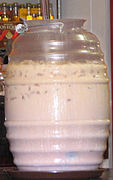Cookbook:Nondairy Milk
| Nondairy Milk | |
|---|---|
| Category | Beverages |
Cookbook | Recipes | Ingredients | Equipment | Techniques | Cookbook Disambiguation Pages | Ingredients
Nondairy milks and creams are products that mimic the taste and texture of milk. They are frequently used as vegan substitutes for dairy milk or for those who have a dietary intolerance to milk. However, no one nondairy milk can be used as a perfect substitute for milk. Many varieties of nondairy milk can be purchased commercially, though some will be hard to find and must be made at home.
Characteristics
[edit | edit source]The primary characteristics shared by most nondairy milks are a creamy consistency, neutral or mild flavor, and off-white color.
Types
[edit | edit source]Grains/seeds
[edit | edit source]Nuts
[edit | edit source]Legumes
[edit | edit source]Other
[edit | edit source]Production
[edit | edit source]Generally, many varieties of nondairy milk are made by soaking their primary ingredient in water before blending into a smooth mixture. The solids are then strained out, and additional thickeners, stabilizers, sweeteners, and/or flavorings may be added to reach the final product.
Use
[edit | edit source]In addition to being consumed on their own, nondairy milks can be used in many of the same applications as milk, although no nondairy milk will be a perfect substitute. The behavior and properties of a given nondairy milk will depend on its ingredients, and some experimentation may be needed to achieve the desired results when substituting nondairy for dairy.
Gallery
[edit | edit source]-
An assortment of commercially-available nondairy milks, including almond, hemp, soy, coconut, and rice
-
Left to right: rice milk, canary seed milk, oat milk, soy milk
-
Oat milk
-
Soy milk
-
Hemp milk
-
Coconut milk
-
Tiger nut milk
-
Pea milk








